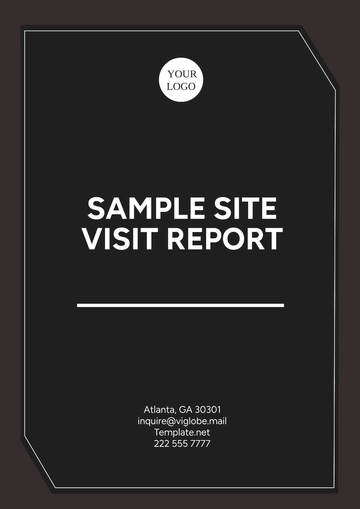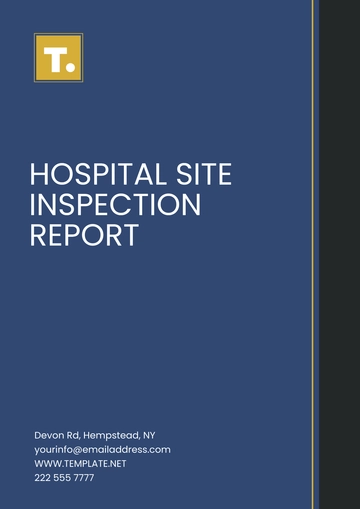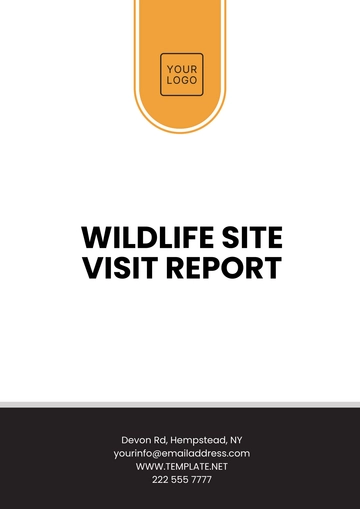Free Plant Site Visit Report

I. Introduction
The purpose of this report is to provide a detailed summary of the findings and observations made during a recent site visit to [Your Company Name] Plant. The visit aimed to evaluate the plant's operations, equipment condition, safety protocols, compliance with environmental and safety regulations, as well as overall operational performance. This report also outlines recommendations for further improvements to maintain the plant’s competitiveness and safety standards in the future.
II. Date and Attendees
A. Date of Visit
The site visit took place on January 15, 2050.
B. Attendees
The following personnel were present during the site visit:
[Your Name], Senior Engineer
Elvie Block, Safety Officer
Lester Nolan, Compliance Auditor
Drake Feeney, Plant Manager
Floyd Cremin, Environmental Consultant
Porter Hoppe, Maintenance Supervisor
III. Facility Overview
[Your Company Name] Plant is a 150,000-square-foot facility, primarily engaged in producing automotive components for electric and autonomous vehicles. The plant has evolved with the integration of advanced robotics and AI-driven quality control systems, operating 24/7 with three shifts. It employs approximately 300 workers, alongside a fleet of automated material-handling robots.
Parameter | Details |
|---|---|
Location | [Your Company Address] |
Size | 150,000 sq. ft. |
Number of Employees | 300 |
Operational Hours | 24/7 |
Primary Product | Automotive components (electric vehicles) |
Key Equipment | CNC machines, injection molding machines, robotic assembly arms, AI-driven quality systems |
IV. Observations
The following observations were made during the site visit:
A. Operations
The plant operates three primary production lines focusing on the assembly of electric vehicle parts such as batteries, lightweight body components, and drive modules. All production lines were running smoothly during the visit. The use of automated guided vehicles (AGVs) to transport materials between production stages has significantly reduced manual labor and improved workflow efficiency. There was minimal downtime across the production lines, indicating efficient process control.
B. Equipment
The equipment across the plant was in excellent condition, with evidence of regular preventive maintenance. The site has integrated next-gen CNC machines, 3D printing units for prototype development, and AI-controlled robotic arms for precision assembly. A few older machines were noted in the injection molding department, and while they were functioning adequately, they could benefit from future upgrades to align with newer technologies.
C. Safety Protocols
Safety protocols at the plant were stringently followed. Employees were equipped with the necessary personal protective equipment (PPE) such as augmented reality (AR) safety helmets and smart wearables that track health metrics in real-time. Emergency exits were marked, and automated fire suppression systems were fully operational. Drone-based monitoring systems ensured ongoing compliance with safety protocols, with no visible lapses or hazards identified during the visit. Safety drills were conducted monthly, with all personnel well-prepared for emergency scenarios.
V. Compliance Assessment
The plant was thoroughly assessed for compliance with a range of regulatory and industry standards, including:
A. Environmental Regulations
The plant adheres to environmental regulations, including carbon emission caps, waste disposal protocols, and water recycling measures. The plant's commitment to sustainability was evident in its solar energy generation system, which offsets 40% of its electricity usage. Smart sensors regulate energy consumption across different areas of the plant, ensuring minimal wastage. Proper documentation for emissions and waste handling was available, and there were no violations of environmental standards.
B. Occupational Safety and Health Administration (OSHA) Standards
The plant demonstrated full compliance with OSHA standards, with automated safety barriers and real-time incident tracking systems in place. Regular inspections were documented, and all machinery was equipped with proper safety guards. An AI-powered risk assessment tool continuously monitors working conditions to detect any potential hazards. Emergency procedures were up to date and accessible across the facility's digital dashboards.
C. Industry Standards
The plant met or exceeded industry standards for quality control, efficiency, and sustainability. Real-time monitoring systems have been implemented to assess production efficiency, and automated inspection drones check for product defects at various stages of the manufacturing process. Digital twins of equipment allow operators to anticipate maintenance needs and prevent unplanned downtime.
VI. Recommendations
Based on the site visit observations and compliance assessment, the following recommendations are provided to further enhance plant operations:
Upgrade older equipment in the injection molding department. While the machines are functioning adequately, newer models with energy-efficient features and AI-assisted quality control could further improve efficiency and reduce long-term costs.
Expand training programs for new and existing employees. As automation continues to evolve, employees should undergo AI and robotics training to operate and maintain new technologies more effectively.
Enhance ventilation systems throughout the facility. While current systems meet standards, upgrading to smart climate control systems with air quality monitoring sensors could improve employee comfort and reduce potential airborne hazards.
Regularly review and update compliance documentation to ensure alignment with the latest regulatory requirements, particularly in environmental and occupational safety areas. This will ensure that the plant remains at the forefront of industry standards.
VII. Conclusion
The site visit to [Your Company Name] Plant highlighted the facility’s operational efficiency, strong safety culture, and commitment to regulatory compliance. The plant is well-positioned to continue its leadership in the production of automotive components for the electric vehicle market. However, implementing the recommended improvements—particularly around equipment upgrades, employee training, and ventilation—will help the plant maintain its competitive edge in an increasingly automated and environmentally-conscious industry.
VIII. Appendices
Additional supporting documents and detailed data are included in the following appendices:
Appendix A: Detailed Equipment List
Appendix B: Safety Protocol Documentation
Appendix C: Compliance Certificates
Appendix D: Energy Efficiency Report (2050)
Appendix E: Environmental Impact Analysis
- 100% Customizable, free editor
- Access 1 Million+ Templates, photo’s & graphics
- Download or share as a template
- Click and replace photos, graphics, text, backgrounds
- Resize, crop, AI write & more
- Access advanced editor
Capture essential data from plant site visits with Template.net’s Plant Site Visit Report Template. This editable and customizable template is tailored for various industries, allowing you to easily modify sections to fit your specific needs. Use our Editable in our Ai Editor Tool for a quick and efficient way to create professional reports that enhance your plant operations.
You may also like
- Sales Report
- Daily Report
- Project Report
- Business Report
- Weekly Report
- Incident Report
- Annual Report
- Report Layout
- Report Design
- Progress Report
- Marketing Report
- Company Report
- Monthly Report
- Audit Report
- Status Report
- School Report
- Reports Hr
- Management Report
- Project Status Report
- Handover Report
- Health And Safety Report
- Restaurant Report
- Construction Report
- Research Report
- Evaluation Report
- Investigation Report
- Employee Report
- Advertising Report
- Weekly Status Report
- Project Management Report
- Finance Report
- Service Report
- Technical Report
- Meeting Report
- Quarterly Report
- Inspection Report
- Medical Report
- Test Report
- Summary Report
- Inventory Report
- Valuation Report
- Operations Report
- Payroll Report
- Training Report
- Job Report
- Case Report
- Performance Report
- Board Report
- Internal Audit Report
- Student Report
- Monthly Management Report
- Small Business Report
- Accident Report
- Call Center Report
- Activity Report
- IT and Software Report
- Internship Report
- Visit Report
- Product Report
- Book Report
- Property Report
- Recruitment Report
- University Report
- Event Report
- SEO Report
- Conference Report
- Narrative Report
- Nursing Home Report
- Preschool Report
- Call Report
- Customer Report
- Employee Incident Report
- Accomplishment Report
- Social Media Report
- Work From Home Report
- Security Report
- Damage Report
- Quality Report
- Internal Report
- Nurse Report
- Real Estate Report
- Hotel Report
- Equipment Report
- Credit Report
- Field Report
- Non Profit Report
- Maintenance Report
- News Report
- Survey Report
- Executive Report
- Law Firm Report
- Advertising Agency Report
- Interior Design Report
- Travel Agency Report
- Stock Report
- Salon Report
- Bug Report
- Workplace Report
- Action Report
- Investor Report
- Cleaning Services Report
- Consulting Report
- Freelancer Report
- Site Visit Report
- Trip Report
- Classroom Observation Report
- Vehicle Report
- Final Report
- Software Report





























